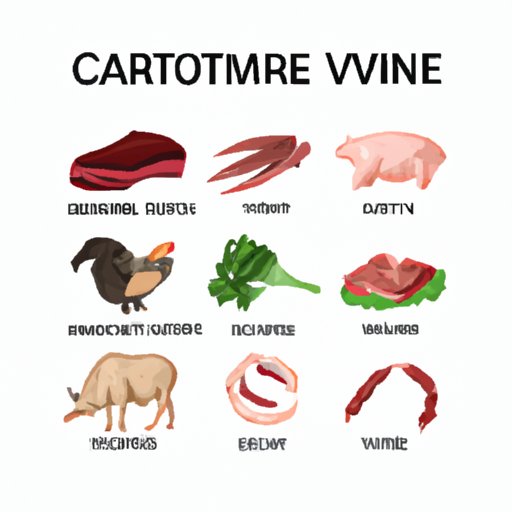
Introduction
The carnivore diet is a dietary plan that has grown in popularity in recent years. The diet plan involves eating only animal-based foods while avoiding all plant-based foods. The purpose of this article is to provide a comprehensive guide to what you can eat on a carnivore diet while exploring the overall health benefits of this dietary plan.
What to Eat on a Carnivore Diet
The foods allowed on the carnivore diet are quite simple – only animal-based foods are allowed while all plant-based foods are avoided. Animal-based foods to eat can include:
- Beef
- Lamb
- Pork
- Poultry (chicken, turkey, duck, etc.)
- Fish and seafood
- Eggs
- Dairy (cheese, butter, cream)
It is recommended that protein sources, such as beef, lamb, pork, poultry, fish, and seafood, should make up the majority of your diet when following a carnivore diet. The reason why some fruits and vegetables are not allowed on the carnivore diet is that these foods contain carbohydrates that can stimulate insulin production in the body and prevent the body from entering the desired state of ketosis.
The Ultimate Guide to Carnivore Diet: Top Foods to Eat to Stay Keto-Friendly
The carnivore diet is often described as a keto-friendly approach to eating. Since the diet is focused on high-fat, moderate-protein intake and limits carbohydrates, it can be a good way to enter ketosis and maintain a state of fat burning. Some examples of keto-friendly foods to eat on the carnivore diet include:
- Beef chuck roast
- Liver
- Bacon
- Eggs
- Cheese
- Grass-fed butter
- Salmon
- Sardines
It is important to note that although some foods are keto-friendly, they may not be included in the carnivore diet. For example, nuts, seeds, avocados, and coconut oil are often part of a ketogenic diet but are not allowed in a pure carnivore diet because they are plant-based.
Carnivore Diet Staples: The Top 5 Foods You Should Always Have in Your Kitchen
When following a carnivore diet, it is important to have certain staples on hand to make meal preparation easier. Here are five essential foods that should be in your kitchen:
- Ground beef
- Beef liver
- Eggs
- Bacon
- Cheese
These foods are all excellent sources of protein, fat, and other essential nutrients necessary for a healthy diet. They can easily be incorporated into various meals and are relatively easy to find and store.
7 Easy and Delicious Carnivore Diet Meals to Try Today
Starting a new dietary plan can be challenging, especially when trying to find tasty and satisfying meals. Here are seven simple and delicious carnivore diet meals to add to your meal plan:
- Grilled chicken thighs with melted cheese
- Hamburger patties with bacon and cheddar cheese
- Beef stew made with chuck roast and bone broth
- Braised lamb chops with herbs and spices
- Salmon cooked in grass-fed butter with a side of steamed broccoli
- Fried eggs with bacon and avocado (optional)
- Beef liver pate served with cheese and pork rinds (optional)
These meals are all easy to prepare and incorporate various sources of protein and fats. They are also delicious and satisfying, making it easier to stick to the carnivore diet throughout the day.
Why Going on a Carnivore Diet Can Benefit Your Health: The Science Behind It
Studies have shown that a carnivore diet can have various health benefits. One such benefit includes weight loss, as the diet is high in protein and fat content, which can increase feelings of satiety and reduce overall calorie intake. Other potential benefits of the carnivore diet can include improved gut health, reduced inflammation, and reduced risk of certain chronic diseases.
However, it is important to note that the carnivore diet may not be suitable for all populations, especially those with pre-existing health conditions. It is also essential to ensure the appropriate intake of essential vitamins and minerals that are typically found in fruits and vegetables when following the carnivore diet.
Going Carnivore: How to Transition to a Meat-Only Diet and Still Meet Your Nutritional Needs
When transitioning to the carnivore diet, it is essential to do so safely and effectively. Here are some tips on how to transition to a meat-only diet while still meeting your nutritional needs:
- Gradually decrease carbohydrate intake: Before starting the diet, begin by gradually decreasing carbohydrate intake and increasing protein and fat intake to prepare the body for the transition.
- Supplement with vitamins and minerals: To ensure that your body is receiving necessary nutrients typically found in fruits and vegetables, consider supplementing vitamins and minerals to your diet.
- Consult a healthcare professional: Before starting a carnivore diet, consult with a healthcare professional, especially those with pre-existing health conditions such as diabetes or other chronic illnesses.
Conclusion
The carnivore diet is a unique dietary plan that involves eating only animal-based foods while avoiding all plant-based foods. This article has provided a comprehensive guide to what you can eat on a carnivore diet while exploring the overall health benefits of this dietary plan. Along with the suggested meals, it is essential to consult with a healthcare professional before making any significant dietary changes. Ultimately, the carnivore diet may be a suitable option for some individuals, but it is essential to consider individual needs when making dietary decisions.




